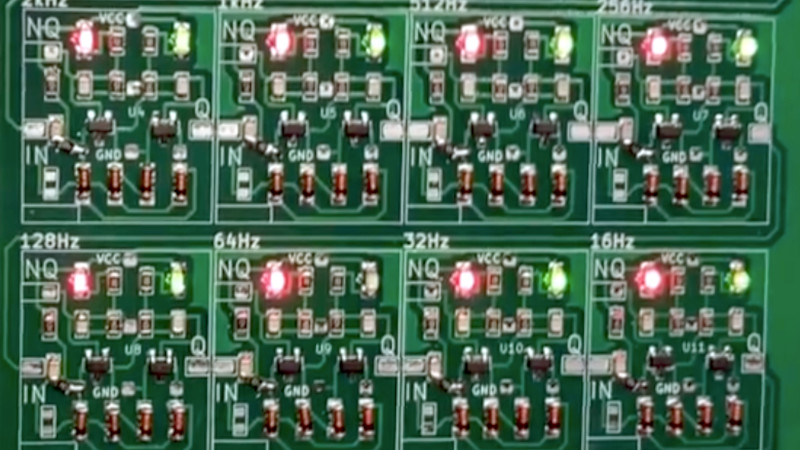Most of us know that a quartz clock uses a higher frequency crystal oscillator and a chain of divider circuits to generate a 1 Hz pulse train. It’s usual to have a 32.768 kHz crystal and a 15-stage divider chain, which in turn normally sits inside an integrated circuit. Not so for [Bobricius], who’s created just such a divider chain using discrete components.
The circuit of a transistor divider is simple enough, and he’s simply replicated it fifteen times in surface mount parts on a PCB with an oscillator forming the remaining square in a 4 by 4 grid. In the video below the break we can see him measuring the frequency at each point, down to the final second. It’s used as the timing generator for an all transistor clock, and as we can see it continues that trend. Below the break is a video showing all the frequencies in the chain.
This project is part of our awesome 2025 One Hertz Challenge, for all things working on one second cycles. Enter your own things that go tick and tock, we’d live to see them!
















“Most of us know that a quartz clock uses a higher frequency crystal oscillator and a chain of divider circuits to generate a 1 Hz pulse train.”
Uhhh count me in the minority then I guess.
But now you know! Welcome to the majority!
In case anyone is not familiar with computing at the lower levels: You typically have a clock that steps your computing engine to the next thing that its going to do. Every ‘tick’ of the clock is the trigger for the next step. In modern computing, we use quartz crystals specially tuned to create a regular rhythm of ticks.
If we had a clock running at 1Hz, computing would be very slow. It would take us several seconds to add together two numbers. We want to work faster than that, but might also need to regularly count smaller numbers (like a single second.) Because computing is binary, we go up and down by powers of two. The 32,768 Hz is a crystal that ticks 32,768 times in a second. If you count every other tick you get a clock that ticks 16,384 times a second. If you count only every 4th you get 8192 – and so on.
As explained above, if you count every 15th tick you get 1 once per second. That’s how computer clocks work.
Did you mean “every 2^15th tick”?
It’s worth noting that a simple quartz watch doesn’t do any computing etc.
We use 32768 Hz clocks because higher clock speed means higher stability and commonly accuracy. It’s particularly important in a watch because otherwise the impact from vibration etc would be too high. With a 1 Hz mechanical oscillator, waving your hand would significantly affect the timekeeping
Hm. Not even a schematic of the ÷2 circuit. I was curious about how he did this with just two transistors and some diodes.
Flipflop
Known as a bi-stable multivibrator back in the day.
Yes, of course, but I was curious about the specific design.
Today I finally realized a 32.768 kHz crystal frequency was all about the powers of two. How I didn’t see that totally obvious number all these years…
It’s also why all watches that beep do so on the same note (a flat C) because they use the 2048 or 4096 signal further up the chain.
What key are the watches playing in that they just don’t call it a B? I’m curious as to how they get to “a flat C” using 2048 or 4096 hz?
C7 is 2093 Hz, B6 is 1975.53 Hz. So it’s not a C-flat (B), but a slightly flat C.
So a B#! Slightly. Thanks!
Wasteful use of components.
I have Tektronix instruments where divide by N (N=2 or 5 or 10) is done with 2 transistors, 2 diodes, 2 capacitors, 5 resistors.
FFI, see the Tek184 schematic.
Yours is a refreshing comment on this Summer’s Eve. Drink deep!
I should note the 184 only used N=2,5,10, but the same circuit could divide by any integer up to, say, 16.
Basic technique: each input pulse dumps a glug of charge onto a capacitor, thus raising the voltage. After sufficient glugs the voltage exceeds a threshold, the charge is drained from the capacitor and causes a pulse to the next stage.
Increasing a resistor reduced the size of the glug and increased the division ratio.
Skill plus imagination enables possibilities that brute force cannot achieve.
a fusion of digital an analog
All circuits are analogue, but some interpret their inputs as digital signals, and have discrete non-overlapping output ranges.
Exceptions: photon counting and femtoamp circuits.
Hard to believe, but I actually invented/designed such a thing for a military product. The requirement was a 1 minute output. The only “clock” available was a 1 second pulse from a mechanical clock. Yes as I recall, the chain went /5,/4,/3. It’s been nearly 60 years, so I don’t remember the schematics, but it was all discrete (ICs were still an academic curosity) with more parts than you describe. It had to work, guaranteed, in a pretty rough mil environment. Temp and vibration both an issue. Each stage was packaged in a little cord-wood module. The modules did fine in environmental testing. The circuit board they were attached to did not.
it’s also about being the lowest such power beyond the range of human hearing.
I made a crystal calibrator with an IC decade divider so I could tune my Hallicrafters Sx-25 Super Defiant when I was a kid in the 1970s. I still have and use both. You can change the frequency/spacing with a rotary switch. It’s almost like having a digital tuner.
At one time middle C was defined as 256 Hz but since the A above was redefined as 440 Hz for orchestral tuning in 1939 it is now 261.3 Hz. According to Wikipedia.